A balcony is like a blank canvas waiting to be transformed into your personal slice of nature. You’ll discover how to maximize every square inch of your outdoor space with strategic plant choices and clever arrangements. From cascading flowers that create visual drama to compact herb gardens that serve both form and function, these nine plant ideas will help you design a thriving garden sanctuary; even the smallest balcony can become an impressive green retreat.
Contents
- 1 Hanging Basket Petunias and Pansies
- 2 Vertical Herb Garden Essentials
- 3 Space-Saving Climbing Plants
- 4 Container-Friendly Dwarf Citrus Trees
- 5 Compact Succulents and Cacti Collections
- 6 Trailing Vines for Balcony Rails
- 7 Mini Vegetable Garden Solutions
- 8 Low-Maintenance Air Plants Display
- 9 Seasonal Flowering Plants in Stackable Pots
Hanging Basket Petunias and Pansies
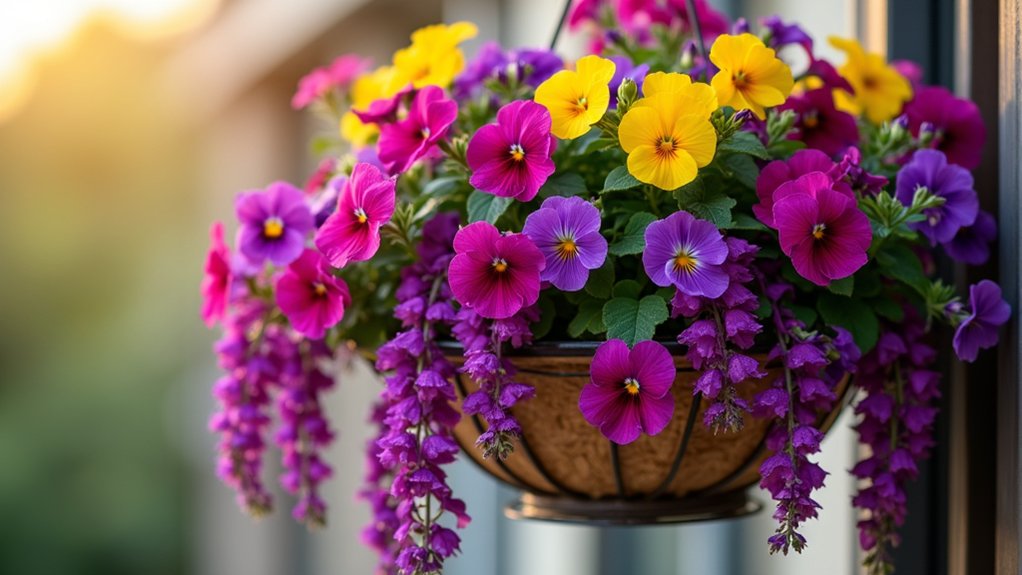
Hanging basket petunias and pansies create cascading waves of vibrant color perfect for small balcony spaces. These flowering plants combine beautifully, with petunias offering trumpet-shaped blooms in various colors and trailing habits, while pansies contribute their distinctive “face-like” markings and compact form.
Together, they create full, lush baskets that add visual interest at eye level and above, maximizing vertical growing space on balconies.
- Light: Full sun to partial shade, minimum 6 hours of direct sunlight daily
- Water: Keep soil consistently moist but not waterlogged
- Soil: Well-draining potting mix rich in organic matter
- Temperature: 60-75°F (15-24°C)
- Container: Hanging baskets with drainage holes, minimum 12 inches diameter
- Spacing: 4-6 inches between plants
- Fertilizer: Balanced water-soluble fertilizer every 2 weeks during growing season
Regular deadheading spent blooms encourages continuous flowering and prevents seed formation, which can reduce blooming.
Trim back leggy stems to promote bushier growth and prevent the basket from becoming unbalanced.
Monitor the soil moisture daily during hot weather, as hanging baskets can dry out quickly.
To extend the blooming season, pinch back growth tips early in the season and protect baskets from strong winds that can damage delicate flowers and stems.
Vertical Herb Garden Essentials

A vertical herb garden maximizes limited balcony space by growing upward instead of outward, typically featuring tiered planters, pocket organizers, or mounted containers arranged on walls or railings.
These space-saving gardens can incorporate multiple herb varieties in a compact footprint, creating an attractive living wall that’s both decorative and functional for culinary purposes.
The modular nature of vertical herb gardens allows for easy access to fresh herbs while adding a lush, green element to small balcony spaces.
Growing Conditions:
- 6-8 hours of direct sunlight daily, with partial afternoon shade in hot climates
- Well-draining potting soil mixed with 30% perlite for proper aeration
- Container depth of at least 6 inches for most herbs
- Consistent moisture without waterlogging; soil should feel slightly damp
- Temperature range between 65-70°F (18-21°C)
- Good air circulation between plants to prevent fungal issues
Regular pruning and harvesting are essential for maintaining a healthy vertical herb garden.
Trim herbs frequently to encourage bushier growth and prevent flowering, which can make the leaves bitter.
Remove any yellowing or dead foliage promptly, and rotate containers periodically to ensure even growth.
Feed plants monthly with a balanced, water-soluble fertilizer during the growing season, and check mounting hardware or support structures regularly to ensure they remain secure and stable.
Space-Saving Climbing Plants
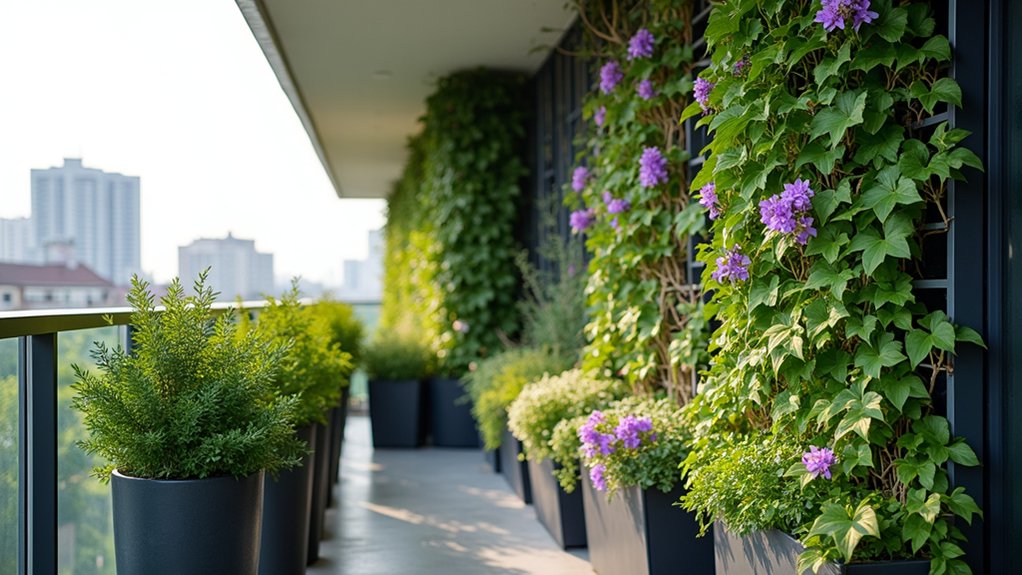
Climbing plants offer an ingenious solution for maximizing limited balcony space by growing vertically along trellises, railings, or walls.
These versatile plants create living screens that provide privacy while adding visual interest through their trailing vines, vibrant flowers, or decorative foliage. Common varieties suitable for balconies include clematis, jasmine, morning glory, and climbing roses, which can transform bare vertical surfaces into lush, green tapestries.
- Light requirements: Most climbing plants need 6-8 hours of direct sunlight daily, though some varieties tolerate partial shade
- Water needs: Regular watering to maintain consistently moist soil, avoiding waterlogged conditions
- Soil preferences: Well-draining potting mix enriched with organic matter
- Container requirements: Deep pots with adequate drainage holes
- Temperature range: Generally 60-75°F (15-24°C), though varies by species
- Support structure: Sturdy trellis, wire mesh, or garden twine secured to railings
Regular maintenance is essential for keeping climbing plants healthy and controlled in a balcony setting.
Prune regularly to maintain desired shape and prevent overcrowding, removing dead or yellowing foliage promptly.
Train new growth by gently weaving stems through support structures or tying them with soft plant ties, and monitor for signs of pest infestation or disease, especially in dense growth areas.
Fertilize monthly during the growing season with a balanced, water-soluble fertilizer to promote healthy growth and abundant blooming.
Container-Friendly Dwarf Citrus Trees
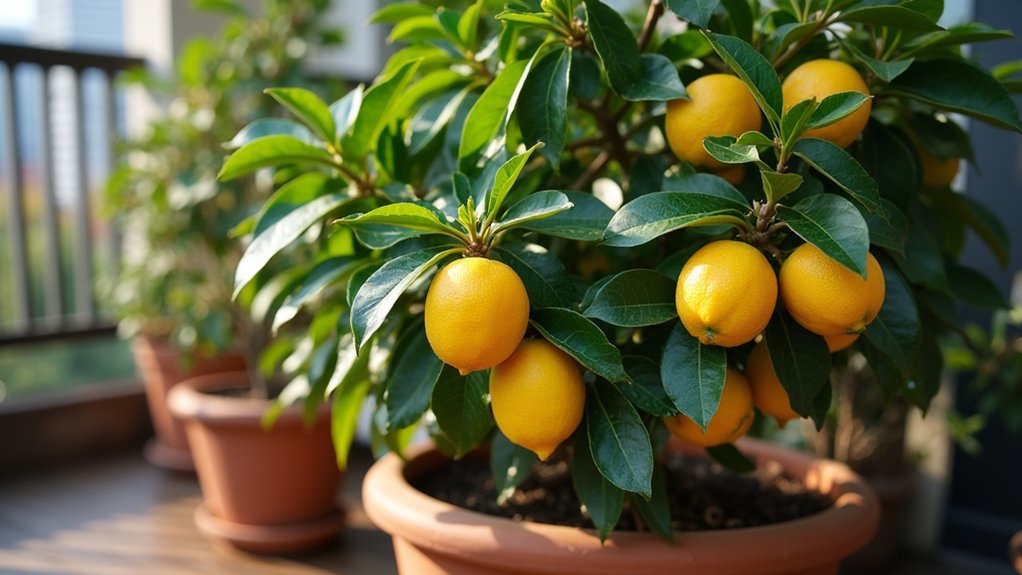
Dwarf citrus trees are compact versions of their full-sized counterparts, making them perfect for balcony gardens. These small trees typically grow 2-6 feet tall when container-grown and produce full-sized fruits while maintaining a manageable shape. Popular varieties include Meyer lemons, kumquats, and calamondin oranges, which offer both ornamental value with their glossy evergreen leaves and fragrant blossoms, as well as edible fruits.
- Light: 6-8 hours of direct sunlight daily; south or southwest-facing location preferred
- Water: Consistent moisture with thorough drainage; water when top 1-2 inches of soil feels dry
- Soil: Well-draining citrus mix with pH 6.0-7.0
- Temperature: 55-85°F (13-29°C); protect from frost
- Container: 15-20 gallon pot with drainage holes
- Humidity: Moderate to high; mist leaves regularly in dry conditions
- Fertilizer: Balanced citrus fertilizer every 6-8 weeks during growing season
Regular pruning to maintain shape and remove dead branches is essential for container-grown dwarf citrus trees.
Move plants indoors when temperatures drop below 50°F (10°C), and gradually transition them between indoor and outdoor environments to prevent shock.
Monitor for pests like spider mites and scale insects, especially when trees are kept indoors.
During the fruiting period, thin excess fruits to prevent branch strain and ensure remaining fruits develop properly.
Compact Succulents and Cacti Collections
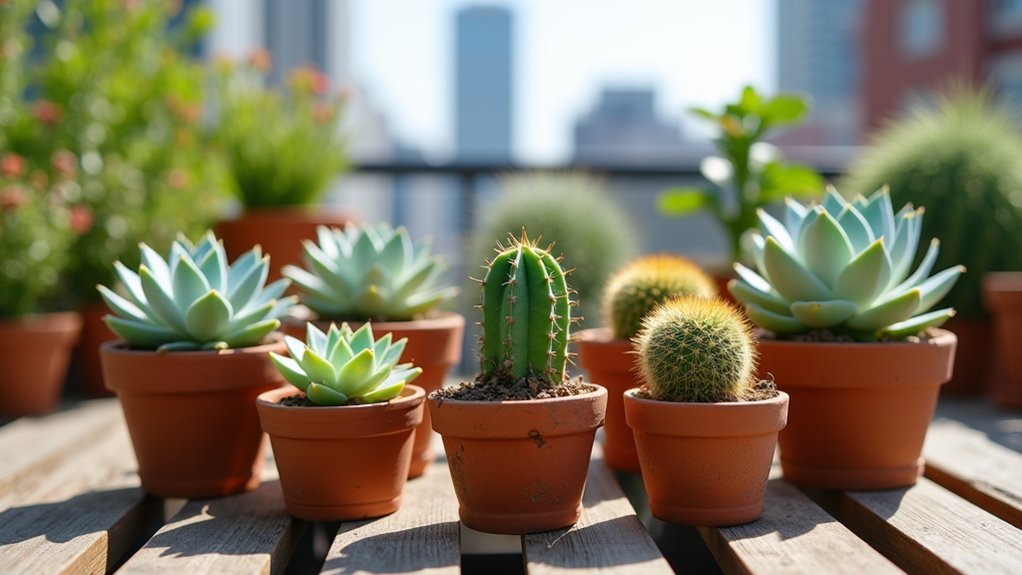
Succulents and cacti collections offer an ideal solution for balcony gardening, combining striking architectural forms with minimal space requirements. These drought-tolerant plants come in diverse shapes, sizes, and colors, from rosette-forming echeverias to columnar cacti, creating visually appealing arrangements in small containers. Their thick, fleshy leaves and stems store water, making them naturally adapted to balcony conditions where space and maintenance time may be limited.
- Light: 6+ hours of direct sunlight daily, though some varieties tolerate partial shade
- Water: Allow soil to dry completely between waterings; reduce watering in winter
- Soil: Fast-draining cactus mix or regular potting soil mixed with sand and perlite
- Temperature: Prefer warm conditions, protect from frost; ideal range 60-80°F
- Container: Well-draining pots with drainage holes; terracotta works especially well
- Spacing: Can be planted closely together in arrangements, leaving room for growth
- Fertilizer: Light feeding with balanced fertilizer during growing season only
To maintain healthy succulent and cacti collections, regular inspection for pests like mealybugs and scale insects is essential. Remove dead leaves promptly to prevent rot, and rotate containers periodically to ensure even growth.
During extreme weather conditions, temporarily move containers to protected areas, and prune overgrown specimens to maintain compact growth. Repot every 2-3 years or when plants outgrow their containers, using fresh soil mix to prevent nutrient depletion and maintain proper drainage.
Trailing Vines for Balcony Rails
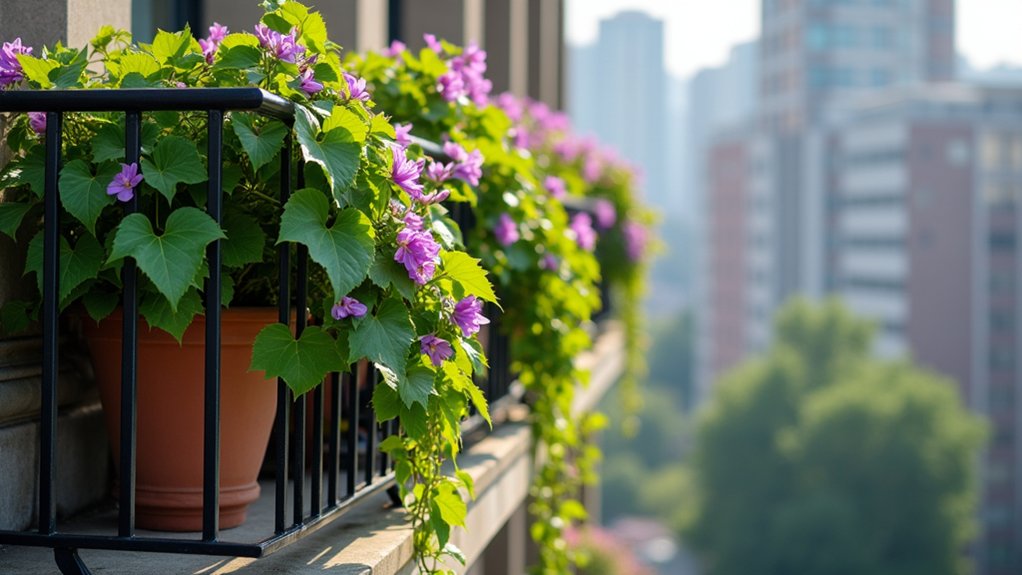
Trailing vines transform balcony railings into living curtains of foliage, creating natural privacy screens and adding vertical interest to small spaces. Popular choices like English Ivy, Clematis, and Morning Glory cascade elegantly over railings, while varieties such as Nasturtium and Trailing Petunias offer both flowing greenery and vibrant blooms.
These versatile plants not only soften harsh architectural lines but also help create a lush, garden-like atmosphere even in the most urban settings.
Growing Conditions:
- Most trailing vines prefer 6-8 hours of direct sunlight daily
- Well-draining potting soil enriched with organic matter
- Regular watering when top inch of soil feels dry
- Containers with adequate drainage holes
- Support structures or guide wires for climbing varieties
- Protection from strong winds in exposed areas
- Ambient temperatures between 60-80°F (15-27°C)
Regular maintenance keeps trailing vines looking their best and prevents them from becoming unruly. Trim back overgrown sections every few weeks during the growing season to maintain desired shape and prevent vines from becoming too heavy for railings.
Remove yellowed or dead foliage promptly to prevent disease spread, and pinch off growing tips to encourage bushier growth and more abundant flowering. During the growing season, fertilize monthly with a balanced, water-soluble fertilizer, and check attachment points regularly to ensure vines remain securely fastened to their supports.
Mini Vegetable Garden Solutions

Mini vegetable gardens transform compact balcony spaces into productive growing areas through creative use of containers, vertical systems, and space-saving techniques. These gardens typically feature a mix of compact vegetables like cherry tomatoes, leafy greens, herbs, and dwarf varieties of larger plants, arranged in tiered planters, hanging baskets, or wall-mounted containers to maximize limited square footage while maintaining accessibility for maintenance.
- Light: 6-8 hours of direct sunlight daily; south or west-facing balconies optimal
- Soil: Well-draining potting mix enriched with organic matter
- Water: Consistent moisture with thorough drainage; daily watering during hot periods
- Container depth: Minimum 6 inches for herbs and lettuce, 12 inches for tomatoes and peppers
- Temperature: Most vegetables thrive in 65-80°F (18-27°C)
- Spacing: 4-6 inches between leafy greens, 12-18 inches for larger vegetables
- Fertilizer: Balanced, water-soluble fertilizer applied every 2-3 weeks
Regular monitoring and proactive care ensure a successful mini vegetable garden. Rotate crops seasonally to prevent soil depletion, prune plants to maintain appropriate size and encourage bushier growth, and inspect frequently for signs of pest infestation or disease.
Remove any yellowing leaves promptly, stake tall plants securely against wind, and harvest vegetables regularly to promote continuous production throughout the growing season.
Low-Maintenance Air Plants Display

Air plants (Tillandsia) create an enchanting display for balconies, offering a unique way to add greenery without taking up precious floor space. These rootless plants naturally grow attached to other surfaces in the wild, making them perfect for vertical gardens, hanging displays, or artistic arrangements in small containers.
Their silvery-gray to bright green leaves grow in rosette patterns, sometimes producing vibrant flowers, and they can be displayed in glass terrariums, mounted on driftwood, or suspended in decorative holders.
- Light: Bright, indirect sunlight; protect from intense afternoon sun
- Water: Mist 2-3 times per week in summer, once weekly in winter
- Temperature: 50-90°F (10-32°C)
- Humidity: Moderate to high
- Mounting: No soil needed; can be mounted on wood, rock, or displayed in glass containers
- Ventilation: Good air circulation required
- Fertilizer: Monthly feeding with air plant-specific fertilizer during growing season
To maintain healthy air plants, rotate them periodically to ensure even growth and prevent them from growing toward one direction.
Remove dust by gently brushing the leaves, and after misting or soaking, shake excess water from the plant’s base to prevent rot. Trim any brown or dead leaves at the base, and if flowering occurs, allow the bloom to naturally die back before removing it.
During winter months, reduce watering frequency but maintain consistent humidity levels through occasional misting.
Seasonal Flowering Plants in Stackable Pots

Stackable pots filled with seasonal flowering plants offer a space-efficient solution for balcony gardening, allowing vertical growth while maximizing limited square footage. These arrangements typically feature graduated pot sizes that nest together or interlock, creating a cascading display of blooms at different heights.
Popular seasonal choices include petunias, geraniums, and pansies for spring and summer, while chrysanthemums and cyclamen work well for fall and winter, enabling year-round color through strategic rotation.
Growing Conditions:
- Place stackable arrangements where they receive 4-6 hours of direct sunlight daily
- Use well-draining potting soil specifically formulated for container gardens
- Monitor moisture levels carefully, as stacked pots can dry out faster than traditional containers
- Space pots to allow adequate air circulation between plants
- Choose pots with proper drainage holes and catchment systems
- Select plants with similar water and light requirements for each stack
Regular maintenance of seasonal flowering plants in stackable arrangements requires periodic rotation of plants as blooms fade and seasons change. Trim spent flowers promptly to encourage continuous blooming and prevent seed formation.
Check structural stability of stacked pots weekly, adjusting as needed to prevent toppling, and inspect connection points between pots for wear.
Consider installing a drip irrigation system with multiple emission points to ensure consistent watering throughout the stack, as manual watering can be challenging for reaching all levels effectively.
